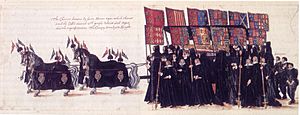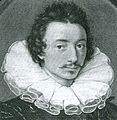Richard Leveson (admiral) facts for kids
Quick facts for kids
Sir Richard Leveson
|
|
|---|---|
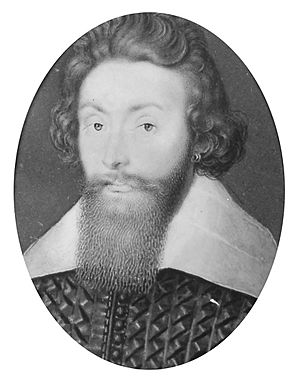
Vice Admiral Sir Richard Leveson, from a portrait miniature by Isaac Oliver.
|
|
| Born | c. 1570 |
| Died | 2 August 1605 London |
| Buried | |
| Allegiance | |
| Service/ |
|
| Years of service | 1586–1605 |
| Rank | Vice-Admiral |
| Commands held | Admiral of the Narrow Seas |
| Battles/wars | Spanish Armada Battle of Cadiz (1596) Islands Voyage Siege of Kinsale Battle of Castlehaven Battle of Sesimbra Bay |
| Relations | Son of Sir Walter Leveson and Anne Corbet |
Sir Richard Leveson (around 1570 – 2 August 1605) was an important Navy officer and politician during the time of Queen Elizabeth I. He came from wealthy families in Shropshire and Staffordshire who owned a lot of land. He was also the son-in-law of Charles Howard, 1st Earl of Nottingham, a very important admiral, and became a Vice-Admiral under him. Richard Leveson was elected to the English parliament twice, representing Shropshire. He faced big money problems because of his father's debts.
Contents
Who was Sir Richard Leveson's family?
Richard Leveson's parents were:
- Sir Walter Leveson (1551-1602) from Lilleshall, Shropshire. His family, the Levesons, were important wool traders and landowners in the Wolverhampton area. They became even bigger landowners by buying church lands after the King closed down many monasteries. Walter was known for improving his lands and served as an MP for Shropshire three times.
- Anne Corbet, daughter of Sir Andrew Corbet of Moreton Corbet. The Corbets were also very powerful landowners in Shropshire. Together, the Leveson and Corbet families had a lot of say in who became an MP for Shropshire.
Both families faced money troubles later on, mostly due to spending too much. For Richard Leveson, these problems came from his father's unusual behavior and mental illness.
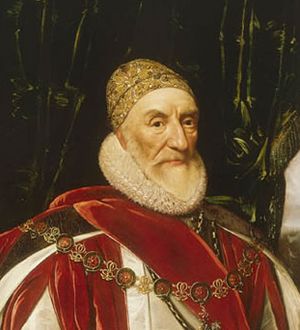
Richard Leveson started his naval career as a teenager. His marriage in 1587 to Margaret, the daughter of Charles Howard, 1st Earl of Nottingham, helped his career greatly. Howard had become the Lord High Admiral in 1585.
Fighting the Spanish Armada and at Cadiz
In 1588, Leveson volunteered on the ship Ark Royal to fight against the Spanish Armada. This was a huge fleet of Spanish ships that tried to invade England. In 1596, he commanded a ship in the attack on Cadiz in Spain. He was knighted for his bravery during this battle.
Later Expeditions and Battles
In 1597, he might have commanded the ship Hope or Nonpareil during the 'Islands' voyage. In 1599, he commanded the Lion in a fleet ready for another Spanish invasion.
In 1600, he became 'Admiral of the Narrow Seas'. He led a group of ships towards the Azores islands to find Spanish treasure ships. The Spanish, however, changed their route and escaped.
In October 1601, he was sent to Ireland to fight the Spanish who had landed there. In December, he fought a battle off Castlehaven. He then entered the harbor of Kinsale and destroyed all the enemy ships there.
The Battle of Sesimbra Bay
In early 1602, Leveson was given command of a strong fleet of English and Dutch ships. Their mission was to attack the Spanish coast. On June 1, 1602, near Lisbon, they heard about a large Spanish ship called a carrack and eleven galleys in Cezimbra Bay.
On June 3, Leveson found the Spanish ships. They were protected by the guns of a castle. Even with fewer ships, Leveson bravely attacked. The fight lasted for seven hours. Two of the galleys were burned, and the rest, along with the carrack Saõ Valentinho, surrendered. They were taken to England. Queen Elizabeth I awarded Leveson £3,000 from the prize money.
Final Service and Death
In 1603, after Queen Elizabeth I died, Leveson commanded the fleet in the English Channel. His job was to keep the peace and prevent any trouble during the change of power. This was his last time serving at sea.
In 1604, he was named Lieutenant of the Admiralty of England and Vice-Admiral of England for life. The next year, he was part of an important group sent to Spain to make peace. Soon after returning, he died in London in 1605.
Sir Richard Leveson as a Member of Parliament
Richard Leveson served as a Member of Parliament (MP) twice.
The 1589 Parliament
Richard Leveson was first elected as an MP for Shropshire on November 7, 1588. His father, Walter, was the other MP for the county. This showed how much influence their families had. Richard was only 18 years old when he was elected, which was quite young for an MP at that time. This Parliament was short, lasting only from February to March 1589. Leveson did not play a big role in it.
The 1604 Parliament
When King James I called his first Parliament in 1604, Leveson was very respected. His capture of the Portuguese carrack was still famous. At Queen Elizabeth I's funeral, he was one of the knights who helped carry the canopy. King James I also made Leveson a gentleman of his Privy chamber.
Leveson was an obvious choice for MP for Shropshire. Two important local gentlemen, Vincent Corbet (Leveson's uncle) and Francis Newport, even signed his election papers to show their support.
When Parliament met in March 1604, Leveson was chosen to help other MPs take the Oath of Supremacy. He also joined committees that dealt with his father-in-law's family matters. One committee helped his father-in-law's new wife become a British citizen. Another committee helped his sister-in-law, Frances Howard, get her husband's lands after he was involved in a plot against the King.
Parliament also used Leveson's naval knowledge. He was on a committee to help soldiers and sailors who had fought in the Irish war. He also joined a committee about stopping the export of iron cannons.
Leveson died before the next session of Parliament in 1606. He was replaced by Sir Roger Owen.
What were Sir Richard Leveson's money problems?
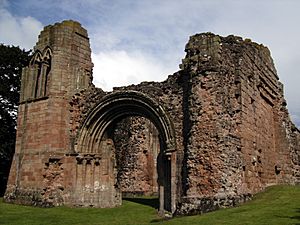
For most of his life, Richard Leveson was set to inherit large estates. But later, he watched as they were put in danger by his father's actions. Richard lived sometimes at Lilleshall, Trentham, or Wolverhampton, but he was often away serving in the Navy.
Richard's father, Sir Walter Leveson, put the family's wealth at great risk. He was accused of piracy and later of sorcery. He started to have serious mental health issues. From 1598, Sir Walter was held in the Fleet Prison because of his huge debts. He owed a lot of money, which grew from about £10,500 in 1591 to £12,000 ten years later.
Sir Walter believed people were plotting against him. He even accused Richard of trying to ruin him. He also tried to harm Richard's wife.
In 1601, an agreement was made for Richard to take over his father's lands and debts. But Richard suspected his father was trying to hide money and property. He wrote to Robert Cecil in 1601, explaining that his family's lands were in ruins because of his father's lack of care.
Richard finally inherited the estates when his father died in 1602. But this meant he also inherited the massive debts. The £3,000 he won from capturing the Portuguese carrack helped, but it wasn't enough to clear all the debts.
His finances were in such bad shape that he had to put the estates under the control of trustees, led by his cousin, Sir John Leveson. Sir John tried to fix things, but Richard died less than three years later.
After Sir Richard's Death
After Richard's death, rumors spread that he had secretly kept a lot of wealth from his naval adventures. In 1607, his cabin steward claimed that Richard had hidden valuable goods like calico and pearls from the captured carrack. These goods should have gone to the Queen. The steward claimed Richard had defrauded the Queen of £40,000.
This was a huge problem for Sir John Leveson. He investigated and found out that the steward had been promised money if he helped get a fine from the Leveson estate. This showed the steward might be lying. Even so, the estate still faced a large fine of £5,000.
After Sir John died in 1615, his wife, Christian, continued the work of fixing the family's money problems. She finally paid off all the debts in 1623. This allowed the estates to pass to Sir Richard Leveson's chosen heir, his godson and third cousin, another Sir Richard Leveson.
How did Sir Richard Leveson die?
Richard Leveson became ill on July 22, 1605, while staying at a friend's house in London. He had a fever and constant diarrhea. He died on August 2, 1605. He was buried on September 2 in St Peter's Collegiate Church, Wolverhampton.
Richard Leveson had made his will on March 17, 1605. He left most of his property to his godson and third cousin, Richard Leveson (1598–1661). He also hoped this young Richard would marry his illegitimate daughter, Anne Fitton. However, the younger Richard Leveson married someone else. Richard Leveson's will also gave £1,000 to his illegitimate half-sister, Penelope.
Who was Sir Richard Leveson married to?
At age 17, Richard Leveson married Margaret Howard in December 1587. She was the daughter of Charles Howard, 1st Earl of Nottingham. They had one child who died young. Margaret later suffered from a mental disorder, possibly due to the loss of her child. Her father, Charles Howard, worried about her and asked for her care after Richard died.
In his last years, Leveson lived at Perton with Mary Fitton. They were distant cousins. They had a daughter named Anne, whom Leveson provided for in his will. Mary Fitton continued to live at Perton after Leveson's death and later married another naval officer.
Images for kids
-
Robert Devereux, 2nd Earl of Essex, who commanded land forces at Cadiz.
-
Statue of Vice Admiral Sir Richard Leveson by Hubert Le Sueur in St Peter's Collegiate Church, Wolverhampton.
-
Possible self-portrait of Isaac Oliver, who painted miniature portraits of Sir Richard Leveson.



